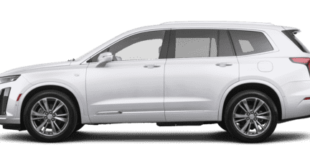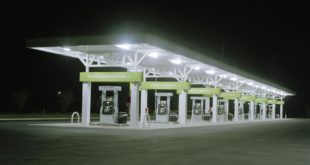
Overview
The 2021 Subaru Ascent stands out in showrooms as the brand’s largest model, but in the American car market it’s overshadowed by a plethora of other popular three-row crossovers. Folks who appreciate Subaru’s wholesome image and ubiquitous all-wheel-drive system will find something to like here: its versatile seating configurations and seven- or eight-person capacities are perfect for families. Every model has driver aids including adaptive cruise, automated emergency braking, and lane-keeping assist. The big Subie’s main drawbacks are its noisy engine, apathetic passing power, and uninspiring driving behavior. Our long-term example has shown us how useful it is for shuttling people and stuff, but also how annoying the beeps and chimes from its driver-assist systems can be if they’re not disabled.
What’s New for 2021?
The latest Ascent receives a handful of new standard features for 2021. These include LED headlights that turn with the steering wheel as well as automatic high-beams. The Touring model also adds another leather upholstery option: Slate Black with silver stitching. And as if the Ascent’s incessant beeping notifications weren’t annoying enough, all models now have a seat-belt chime that’s meant to remind second- and third-row passengers to buckle up.
Pricing and Which One to Buy
- Ascent: $ 34,000 (est.)
- Premium: $ 36,000 (est.)
- Limited: $ 41,000 (est.)
- Touring: $ 47,000 (est.)
We think the Premium model packs the best balance of desirable features and overall value. Every model has all four wheels spun via the same plucky turbocharged four-cylinder powertrain, but the base Ascent and the Premium have slightly better EPA fuel-economy ratings than the top two trims. Compared with the base model, the Premium gets standard upgrades that include blind-spot monitoring, rear cross-traffic alert, heated front seats, a power-adjustable driver’s seat, and a subscription-based Wi-Fi hotspot. Those who want to ditch the second-row bench seat for a pair of captain’s chairs will need the 7-Passenger Convenience package, which isn’t offered on the bottom-rung Ascent. We’d choose that option on our Subie, since it also adds hands-free passive entry, a power-operated rear gate, and rear automated emergency braking.
Engine, Transmission, and Performance
With the company’s trademark all-wheel-drive system, the Ascent is well suited for four-season family road trips. Its 260-horsepower turbocharged 2.5-liter four-cylinder powertrain delivers middling acceleration and can be noisy under duress, but it’ll pull a camper trailer or speedboat. While the Subaru’s continuously variable automatic transmission (CVT) contributed to a noisy ride during our test, the gearless gearbox was otherwise receptive and steady. Its throttle response was particularly abrupt at low speeds around town. The Ascent even has paddle shifters mounted on the steering wheel for those who want more control over the transmission. The Subaru has a comfortable ride that isolated us from rough surfaces. It wore 20-inch wheels but still rode smoothly over bumpy roads and soaked up harsh impacts. Unfortunately, we noticed a lot of wind and road noise while cruising on the highway. While the Subaru lacks the fun-to-drive nature found on the Mazda CX-9, the sizable three-row was nicely composed. Its light and accurate steering responded to quick maneuvers and felt relaxed at higher speeds. The brake pedal on our test vehicle was firm and progressive, with no play or touchy feedback.
Fuel Economy and Real-World MPG
The EPA estimates the 2021 Ascent will earn 21 mpg in the city and 27 mpg on the highway. Those who select the top-tier Limited and Touring models will lose 1 mpg in both categories.
Still, the Ascent has above-average EPA estimates and confirmed the latter in our 200-mile real-world test. The top-of-the-line Ascent Limited earned 26 mpg on our route, matching its EPA highway rating. However, rivals such as the Chevy Traverse and Honda Pilot proved to be even more efficient despite having lower government ratings.
Interior, Comfort, and Cargo
The Ascent’s interior has all the hallmarks of a large crossover, with a raised driving position and versatile seating configurations. While the cabin accommodates a crowd, its third-row-passenger space trails bigger alternatives such as the Volkswagen Atlas. Too bad only the top two versions are available with desirable features such as a heated steering wheel, heated rear seats, memory driver’s seat, power-adjustable passenger seat, and leather-trimmed upholstery. The Ascent can pack up to eight people inside, but in our testing it only held five carry-on bags behind the third row. While that was one less than we fit in the Traverse, the Subaru also had less interior cubby storage than most rivals. Still, it remains a capable travel companion with some clever cargo solutions. These include Velcro straps in the cargo area to hold up the load floor if you need the added room. Our test vehicle had the optional second-row captain’s chairs that use multiple levers for adjustments and will fold nearly flat.
Infotainment and Connectivity
The Subaru infotainment system lacks the customization settings and intuitive controls found on premier competitors. Still, it has features that consumers love, such as Apple CarPlay, Android Auto, and a Wi-Fi hotspot. The standard touchscreen has large onscreen icons that are easy to see and respond to your inputs quickly. While touch-only means there are more opportunities for driver distraction, the screen’s position and large icons alleviate this issue well.
Safety and Driver-Assistance Features
The 2021 Ascent earned a five-star rating from the National Highway Traffic Safety Administration (NHTSA). While the latest model year hasn’t been evaluated by the Insurance Institute for Highway Safety (IIHS), the 2020 Ascent was named a Top Safety Pick+ by the agency. Subaru doesn’t save the best safety and driver-assist technology for the top trims, either. In fact, every Ascent except the base model is available with most upgrades. Key safety features include:
- Standard forward-collision warning and automated emergency braking
- Standard lane-departure warning and lane-keeping assist
- Standard adaptive cruise control
Warranty and Maintenance Coverage
Subaru’s warranty coverage is thoroughly average and fails to offer the complimentary scheduled maintenance that some competitors do.
- Limited warranty covers three years or 36,000 miles
- Powertrain warranty covers five years or 60,000 miles
- No complimentary scheduled maintenance

